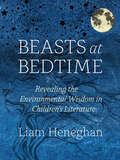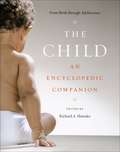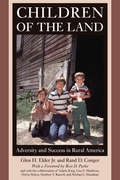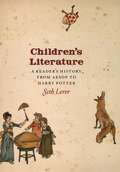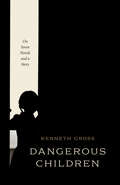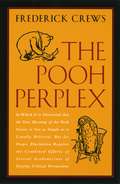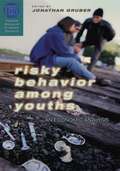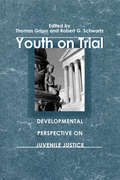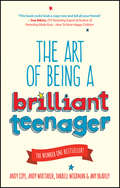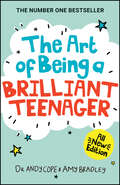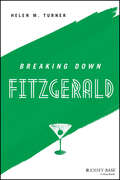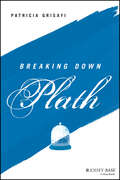- Table View
- List View
Beasts at Bedtime: Revealing the Environmental Wisdom in Children’s Literature
by Liam HeneghanTalking lions, philosophical bears, very hungry caterpillars, wise spiders, altruistic trees, companionable moles, urbane elephants: this is the magnificent menagerie that delights our children at bedtime. Within the entertaining pages of many children’s books, however, also lie profound teachings about the natural world that can help children develop an educated and engaged appreciation of the dynamic environment they inhabit. In Beasts at Bedtime, scientist (and father) Liam Heneghan examines the environmental underpinnings of children’s stories. From Beatrix Potter to Harry Potter, Heneghan unearths the universal insights into our inextricable relationship with nature that underlie so many classic children’s stories. Some of the largest environmental challenges in coming years—from climate instability, the extinction crisis, freshwater depletion, and deforestation—are likely to become even more severe as this generation of children grows up. Though today’s young readers will bear the brunt of these environmental calamities, they will also be able to contribute to environmental solutions if prepared properly. And all it takes is an attentive eye: Heneghan shows how the nature curriculum is already embedded in bedtime stories, from the earliest board books like The Rainbow Fish to contemporary young adult classics like The Hunger Games. Beasts at Bedtime is an awakening to the vital environmental education children’s stories can provide—from the misadventures of The Runaway Bunny to more overt tales like The Lorax. Heneghan serves as our guide, drawing richly upon his own adolescent and parental experiences, as well as his travels in landscapes both experienced and imagined. Organized into thematic sections, the work winds its way through literary forests, colorful characters, and global environments. This book enthralls as it engages. Heneghan as a guide is as charming as he is insightful, showing how kids (and adults) can start to experience the natural world in incredible ways from the comfort of their own rooms. Beasts at Bedtime will help parents, teachers, and guardians extend those cozy times curled up together with a good book into a lifetime of caring for our planet.
Beasts at Bedtime: Revealing the Environmental Wisdom in Children’s Literature
by Liam HeneghanTalking lions, philosophical bears, very hungry caterpillars, wise spiders, altruistic trees, companionable moles, urbane elephants: this is the magnificent menagerie that delights our children at bedtime. Within the entertaining pages of many children’s books, however, also lie profound teachings about the natural world that can help children develop an educated and engaged appreciation of the dynamic environment they inhabit. In Beasts at Bedtime, scientist (and father) Liam Heneghan examines the environmental underpinnings of children’s stories. From Beatrix Potter to Harry Potter, Heneghan unearths the universal insights into our inextricable relationship with nature that underlie so many classic children’s stories. Some of the largest environmental challenges in coming years—from climate instability, the extinction crisis, freshwater depletion, and deforestation—are likely to become even more severe as this generation of children grows up. Though today’s young readers will bear the brunt of these environmental calamities, they will also be able to contribute to environmental solutions if prepared properly. And all it takes is an attentive eye: Heneghan shows how the nature curriculum is already embedded in bedtime stories, from the earliest board books like The Rainbow Fish to contemporary young adult classics like The Hunger Games. Beasts at Bedtime is an awakening to the vital environmental education children’s stories can provide—from the misadventures of The Runaway Bunny to more overt tales like The Lorax. Heneghan serves as our guide, drawing richly upon his own adolescent and parental experiences, as well as his travels in landscapes both experienced and imagined. Organized into thematic sections, the work winds its way through literary forests, colorful characters, and global environments. This book enthralls as it engages. Heneghan as a guide is as charming as he is insightful, showing how kids (and adults) can start to experience the natural world in incredible ways from the comfort of their own rooms. Beasts at Bedtime will help parents, teachers, and guardians extend those cozy times curled up together with a good book into a lifetime of caring for our planet.
The Child: An Encyclopedic Companion
by Richard A. Shweder Thomas R. Bidell Anne C. DaileyThe Child: An Encyclopedic Companion offers both parents and professionals access to the best scholarship from all areas of child studies in a remarkable one-volume reference. Bringing together contemporary research on children and childhood from pediatrics, child psychology, childhood studies, education, sociology, history, law, anthropology, and other related areas, The Child contains more than 500 articles—all written by experts in their fields and overseen by a panel of distinguished editors led by anthropologist Richard A. Shweder. Each entry provides a concise and accessible synopsis of the topic at hand. For example, the entry “Adoption” begins with a general definition, followed by a detailed look at adoption in different cultures and at different times, a summary of the associated mental and developmental issues that can arise, and an overview of applicable legal and public policy. While presenting certain universal facts about children’s development from birth through adolescence, the entries also address the many worlds of childhood both within the United States and around the globe. They consider the ways that in which race, ethnicity, gender, socioeconomic status, and cultural traditions of child rearing can affect children’s experiences of physical and mental health, education, and family. Alongside the topical entries, The Child includes more than forty “Imagining Each Other” essays, which focus on the particular experiences of children in different cultures. In “Work before Play for Yucatec Maya Children,” for example, readers learn of the work responsibilities of some modern-day Mexican children, while in “A Hindu Brahman Boy Is Born Again,” they witness a coming-of-age ritual in contemporary India. Compiled by some of the most distinguished child development researchers in the world, The Child will broaden the current scope of knowledge on children and childhood. It is an unparalleled resource for parents, social workers, researchers, educators, and others who work with children.
The Child: An Encyclopedic Companion
by Richard A. Shweder Thomas R. Bidell Anne C. Dailey Suzanne D. Dixon Peggy J. Miller John ModellThe Child: An Encyclopedic Companion offers both parents and professionals access to the best scholarship from all areas of child studies in a remarkable one-volume reference. Bringing together contemporary research on children and childhood from pediatrics, child psychology, childhood studies, education, sociology, history, law, anthropology, and other related areas, The Child contains more than 500 articles—all written by experts in their fields and overseen by a panel of distinguished editors led by anthropologist Richard A. Shweder. Each entry provides a concise and accessible synopsis of the topic at hand. For example, the entry “Adoption” begins with a general definition, followed by a detailed look at adoption in different cultures and at different times, a summary of the associated mental and developmental issues that can arise, and an overview of applicable legal and public policy. While presenting certain universal facts about children’s development from birth through adolescence, the entries also address the many worlds of childhood both within the United States and around the globe. They consider the ways that in which race, ethnicity, gender, socioeconomic status, and cultural traditions of child rearing can affect children’s experiences of physical and mental health, education, and family. Alongside the topical entries, The Child includes more than forty “Imagining Each Other” essays, which focus on the particular experiences of children in different cultures. In “Work before Play for Yucatec Maya Children,” for example, readers learn of the work responsibilities of some modern-day Mexican children, while in “A Hindu Brahman Boy Is Born Again,” they witness a coming-of-age ritual in contemporary India. Compiled by some of the most distinguished child development researchers in the world, The Child will broaden the current scope of knowledge on children and childhood. It is an unparalleled resource for parents, social workers, researchers, educators, and others who work with children.
Children of the Land: Adversity and Success in Rural America (The John D. and Catherine T. MacArthur Foundation Series on Mental Health and Development, Studies on Successful Adolescent Development)
by Glen H. Elder Jr. Rand D. CongerA century ago, most Americans had ties to the land. Now only one in fifty is engaged in farming and little more than a fourth live in rural communities. Though not new, this exodus from the land represents one of the great social movements of our age and is also symptomatic of an unparalleled transformation of our society. In Children of the Land, the authors ask whether traditional observations about farm families—strong intergenerational ties, productive roles for youth in work and social leadership, dedicated parents and a network of positive engagement in church, school, and community life—apply to three hundred Iowa children who have grown up with some tie to the land. The answer, as this study shows, is a resounding yes. In spite of the hardships they faced during the agricultural crisis of the 1980s, these children, whose lives we follow from the seventh grade to after high school graduation, proved to be remarkably successful, both academically and socially. A moving testament to the distinctly positive lifestyle of Iowa families with connections to the land, this uplifting book also suggests important routes to success for youths in other high risk settings.
Children of the Land: Adversity and Success in Rural America (The John D. and Catherine T. MacArthur Foundation Series on Mental Health and Development, Studies on Successful Adolescent Development)
by Glen H. Elder Jr. Rand D. CongerA century ago, most Americans had ties to the land. Now only one in fifty is engaged in farming and little more than a fourth live in rural communities. Though not new, this exodus from the land represents one of the great social movements of our age and is also symptomatic of an unparalleled transformation of our society. In Children of the Land, the authors ask whether traditional observations about farm families—strong intergenerational ties, productive roles for youth in work and social leadership, dedicated parents and a network of positive engagement in church, school, and community life—apply to three hundred Iowa children who have grown up with some tie to the land. The answer, as this study shows, is a resounding yes. In spite of the hardships they faced during the agricultural crisis of the 1980s, these children, whose lives we follow from the seventh grade to after high school graduation, proved to be remarkably successful, both academically and socially. A moving testament to the distinctly positive lifestyle of Iowa families with connections to the land, this uplifting book also suggests important routes to success for youths in other high risk settings.
Children of the Land: Adversity and Success in Rural America (The John D. and Catherine T. MacArthur Foundation Series on Mental Health and Development, Studies on Successful Adolescent Development)
by Glen H. Elder Jr. Rand D. CongerA century ago, most Americans had ties to the land. Now only one in fifty is engaged in farming and little more than a fourth live in rural communities. Though not new, this exodus from the land represents one of the great social movements of our age and is also symptomatic of an unparalleled transformation of our society. In Children of the Land, the authors ask whether traditional observations about farm families—strong intergenerational ties, productive roles for youth in work and social leadership, dedicated parents and a network of positive engagement in church, school, and community life—apply to three hundred Iowa children who have grown up with some tie to the land. The answer, as this study shows, is a resounding yes. In spite of the hardships they faced during the agricultural crisis of the 1980s, these children, whose lives we follow from the seventh grade to after high school graduation, proved to be remarkably successful, both academically and socially. A moving testament to the distinctly positive lifestyle of Iowa families with connections to the land, this uplifting book also suggests important routes to success for youths in other high risk settings.
Children of the Land: Adversity and Success in Rural America (The John D. and Catherine T. MacArthur Foundation Series on Mental Health and Development, Studies on Successful Adolescent Development)
by Glen H. Elder Jr. Rand D. CongerA century ago, most Americans had ties to the land. Now only one in fifty is engaged in farming and little more than a fourth live in rural communities. Though not new, this exodus from the land represents one of the great social movements of our age and is also symptomatic of an unparalleled transformation of our society. In Children of the Land, the authors ask whether traditional observations about farm families—strong intergenerational ties, productive roles for youth in work and social leadership, dedicated parents and a network of positive engagement in church, school, and community life—apply to three hundred Iowa children who have grown up with some tie to the land. The answer, as this study shows, is a resounding yes. In spite of the hardships they faced during the agricultural crisis of the 1980s, these children, whose lives we follow from the seventh grade to after high school graduation, proved to be remarkably successful, both academically and socially. A moving testament to the distinctly positive lifestyle of Iowa families with connections to the land, this uplifting book also suggests important routes to success for youths in other high risk settings.
Children of the Land: Adversity and Success in Rural America (The John D. and Catherine T. MacArthur Foundation Series on Mental Health and Development, Studies on Successful Adolescent Development)
by Glen H. Elder Jr. Rand D. CongerA century ago, most Americans had ties to the land. Now only one in fifty is engaged in farming and little more than a fourth live in rural communities. Though not new, this exodus from the land represents one of the great social movements of our age and is also symptomatic of an unparalleled transformation of our society. In Children of the Land, the authors ask whether traditional observations about farm families—strong intergenerational ties, productive roles for youth in work and social leadership, dedicated parents and a network of positive engagement in church, school, and community life—apply to three hundred Iowa children who have grown up with some tie to the land. The answer, as this study shows, is a resounding yes. In spite of the hardships they faced during the agricultural crisis of the 1980s, these children, whose lives we follow from the seventh grade to after high school graduation, proved to be remarkably successful, both academically and socially. A moving testament to the distinctly positive lifestyle of Iowa families with connections to the land, this uplifting book also suggests important routes to success for youths in other high risk settings.
Children of the Land: Adversity and Success in Rural America (The John D. and Catherine T. MacArthur Foundation Series on Mental Health and Development, Studies on Successful Adolescent Development)
by Glen H. Elder Jr. Rand D. CongerA century ago, most Americans had ties to the land. Now only one in fifty is engaged in farming and little more than a fourth live in rural communities. Though not new, this exodus from the land represents one of the great social movements of our age and is also symptomatic of an unparalleled transformation of our society. In Children of the Land, the authors ask whether traditional observations about farm families—strong intergenerational ties, productive roles for youth in work and social leadership, dedicated parents and a network of positive engagement in church, school, and community life—apply to three hundred Iowa children who have grown up with some tie to the land. The answer, as this study shows, is a resounding yes. In spite of the hardships they faced during the agricultural crisis of the 1980s, these children, whose lives we follow from the seventh grade to after high school graduation, proved to be remarkably successful, both academically and socially. A moving testament to the distinctly positive lifestyle of Iowa families with connections to the land, this uplifting book also suggests important routes to success for youths in other high risk settings.
Children's Literature: A Reader's History, from Aesop to Harry Potter
by Seth LererEver since children have learned to read, there has been children’s literature. Children’s Literature charts the makings of the Western literary imagination from Aesop’s fables to Mother Goose, from Alice's Adventures in Wonderland to Peter Pan, from Where the Wild Things Are to Harry Potter. The only single-volume work to capture the rich and diverse history of children’s literature in its full panorama, this extraordinary book reveals why J. R. R. Tolkien, Dr. Seuss, Laura Ingalls Wilder, Beatrix Potter, and many others, despite their divergent styles and subject matter, have all resonated with generations of readers. Children’s Literature is an exhilarating quest across centuries, continents, and genres to discover how, and why, we first fall in love with the written word. “Lerer has accomplished something magical. Unlike the many handbooks to children’s literature that synopsize, evaluate, or otherwise guide adults in the selection of materials for children, this work presents a true critical history of the genre. . . . Scholarly, erudite, and all but exhaustive, it is also entertaining and accessible. Lerer takes his subject seriously without making it dull.”—Library Journal (starred review) “Lerer’s history reminds us of the wealth of literature written during the past 2,600 years. . . . With his vast and multidimensional knowledge of literature, he underscores the vital role it plays in forming a child’s imagination. We are made, he suggests, by the books we read.”—San Francisco Chronicle “There are dazzling chapters on John Locke and Empire, and nonsense, and Darwin, but Lerer’s most interesting chapter focuses on girls’ fiction. . . . A brilliant series of readings.”—Diane Purkiss, Times Literary Supplement
Dangerous Children: On Seven Novels and a Story
by Kenneth GrossGross explores our complex fascination with uncanny children in works of fiction. Ranging from Victorian to modern works—Lewis Carroll’s Alice in Wonderland, Carlo Collodi’s Pinocchio, Henry James’s What Maisie Knew, J. M. Barrie’s Peter and Wendy, Franz Kafka’s “The Cares of a Family Man,” Richard Hughes’s A High Wind in Jamaica, Elizabeth Bowen’s The Death of the Heart, and Vladimir Nabokov’s Lolita—Kenneth Gross’s book delves into stories that center around the figure of a strange and dangerous child. Whether written for adults or child readers, or both at once, these stories all show us odd, even frightening visions of innocence. We see these children’s uncanny powers of speech, knowledge, and play, as well as their nonsense and violence. And, in the tales, these child-lives keep changing shape. These are children who are often endangered as much as dangerous, haunted as well as haunting. They speak for lost and unknown childhoods. In looking at these narratives, Gross traces the reader’s thrill of companionship with these unpredictable, often solitary creatures—children curious about the adult world, who while not accommodating its rules, fall into ever more troubling conversations with adult fears and desires. This book asks how such imaginary children, objects of wonder, challenge our ways of seeing the world, our measures of innocence and experience, and our understanding of time and memory.
Dangerous Children: On Seven Novels and a Story
by Kenneth GrossGross explores our complex fascination with uncanny children in works of fiction. Ranging from Victorian to modern works—Lewis Carroll’s Alice in Wonderland, Carlo Collodi’s Pinocchio, Henry James’s What Maisie Knew, J. M. Barrie’s Peter and Wendy, Franz Kafka’s “The Cares of a Family Man,” Richard Hughes’s A High Wind in Jamaica, Elizabeth Bowen’s The Death of the Heart, and Vladimir Nabokov’s Lolita—Kenneth Gross’s book delves into stories that center around the figure of a strange and dangerous child. Whether written for adults or child readers, or both at once, these stories all show us odd, even frightening visions of innocence. We see these children’s uncanny powers of speech, knowledge, and play, as well as their nonsense and violence. And, in the tales, these child-lives keep changing shape. These are children who are often endangered as much as dangerous, haunted as well as haunting. They speak for lost and unknown childhoods. In looking at these narratives, Gross traces the reader’s thrill of companionship with these unpredictable, often solitary creatures—children curious about the adult world, who while not accommodating its rules, fall into ever more troubling conversations with adult fears and desires. This book asks how such imaginary children, objects of wonder, challenge our ways of seeing the world, our measures of innocence and experience, and our understanding of time and memory.
The Pooh Perplex
by Frederick CrewsIn this devastatingly funny classic, Frederick Crews skewers the ego-inflated pretensions of the schools and practitioners of literary criticism popular in the 1960s, including Freudians, Aristotelians, and New Critics. Modeled on the "casebooks" often used in freshman English classes at the time, The Pooh Perplex contains twelve essays written in different critical voices, complete with ridiculous footnotes, tongue-in-cheek "questions and study projects," and hilarious biographical notes on the contributors. This edition contains a new preface by the author that compares literary theory then and now and identifies some of the real-life critics who were spoofed in certain chapters.
Risky Behavior among Youths: An Economic Analysis (National Bureau of Economic Research Conference Report)
by Jonathan GruberEvery day young people engage in risky behaviors that affect not only their immediate well-being but their long-term health and safety. These well-honed essays apply diverse economic analyses to a wide range of unsafe activities, including teen drinking and driving, smoking, drug use, unprotected sex, and criminal activity. Economic principles are further applied to mental health and performance issues such as teenage depression, suicide, nutritional disorders, and high school dropout rates. Together, the essays yield notable findings: price and regulatory incentives are critical determinants of high-risk behavior, suggesting that youths do apply some sort of cost/benefit calculation when making decisions; the macroeconomic environment in which those decisions are made matters greatly; and youths who pursue high-risk behaviors are significantly more likely to engage in similar behaviors as adults. This important volume provides both a key data source for public policy makers and a clear affirmation of the usefulness of economic analysis to our understanding of risky behavior.
Risky Behavior among Youths: An Economic Analysis (National Bureau of Economic Research Conference Report)
by Jonathan GruberEvery day young people engage in risky behaviors that affect not only their immediate well-being but their long-term health and safety. These well-honed essays apply diverse economic analyses to a wide range of unsafe activities, including teen drinking and driving, smoking, drug use, unprotected sex, and criminal activity. Economic principles are further applied to mental health and performance issues such as teenage depression, suicide, nutritional disorders, and high school dropout rates. Together, the essays yield notable findings: price and regulatory incentives are critical determinants of high-risk behavior, suggesting that youths do apply some sort of cost/benefit calculation when making decisions; the macroeconomic environment in which those decisions are made matters greatly; and youths who pursue high-risk behaviors are significantly more likely to engage in similar behaviors as adults. This important volume provides both a key data source for public policy makers and a clear affirmation of the usefulness of economic analysis to our understanding of risky behavior.
Youth on Trial: A Developmental Perspective on Juvenile Justice (The John D. and Catherine T. MacArthur Foundation Series on Mental Health and Development, Research Network on Adolescent Development and Juvenile Justice)
by Thomas Grisso Robert G. SchwartzIt is often said that a teen "old enough to do the crime is old enough to do the time," but are teens really mature and capable enough to participate fully and fairly in adult criminal court? In this book—the fruit of the MacArthur Foundation Network on Adolescent Development and Juvenile Justice—a wide range of leaders in developmental psychology and law combine their expertise to investigate the current limitations of our youth policy. The first part of the book establishes a developmental perspective on juvenile justice; the second and third parts then apply this perspective to issues of adolescents' capacities as trial defendants and questions of legal culpability. Underlying the entire work is the assumption that an enlightened juvenile justice system cannot ignore the developmental psychological realities of adolescence. Not only a state-of-the-art assessment of the conceptual and empirical issues in the forensic assessment of youth, Youth on Trial is also a call to reintroduce sound, humane public policy into our justice system.. Contributors: Richard Barnum, Richard J. Bonnie, Emily Buss, Elizabeth Cauffman, Gary L. Crippen, Jeffrey Fagan, Barry C. Feld, Sandra Graham, Thomas Grisso, Colleen Halliday, Alan E. Kazdin, N. Dickon Reppucci, Robert G. Schwartz, Elizabeth Scott, Laurence Steinberg, Ann Tobey, Jennifer L. Woolard, Franklin E. Zimring
The Art of Being a Brilliant Teenager
by Andy Whittaker Andy Cope Darrell Woodman Amy BradleyCalling all teenagers—quit the moaning and start loving life! Don't be a cliché. Don't stay in your bedroom grunting and grumbling. How about getting motivated, energized and start making a difference?! The Art of Being A Brilliant Teenager teaches you how to become your very best self—and how to figure out who that is, exactly. The bestselling authors of The Art of Being Brilliant and Be Brilliant Everyday are experts in the art of happiness and positive psychology and, with this new book, you'll find your way to becoming brilliant at school, work, and life in general. Stay cool under all the pressures you're facing, and plot a map for the future that takes you wherever it is you want to go. Become proactive, determined, successful and most importantly: happy! Fact: your life span is about four thousand weeks. It seems like a lot, but it's not. Complaining about life, homework, parents, and relationships may be normal now, but don't let it become your defining trait. When you're forty years old and still moaning, a big chunk of your four thousand weeks have slipped by, and you're no closer to happiness than you were as a teen. This book is a guide to starting the journey to your ideal life now, instead of wasting time being a drip. Discover the real you, and what you want out of life Stop moaning and get moving now, while there's plenty of time Lose your bad habits before they become your personality Figure out how you want to contribute, and find a way to do it The bottom line is this: it's easy to be the average version of yourself, but is that really all you want? Don't you want to achieve something? Get started now. The Art of Being A Brilliant Teenager helps you figure out where you want to go, and how to get there. So, whether you're an ambitious teenager, a parent or teacher desperate to turn a down-beat teenager into a ray of positivity and delight, How to Be a Brilliant Teenager is here to help.
The Art of Being a Brilliant Teenager
by Andy Whittaker Andy Cope Darrell Woodman Amy BradleyCalling all teenagers—quit the moaning and start loving life! Don't be a cliché. Don't stay in your bedroom grunting and grumbling. How about getting motivated, energized and start making a difference?! The Art of Being A Brilliant Teenager teaches you how to become your very best self—and how to figure out who that is, exactly. The bestselling authors of The Art of Being Brilliant and Be Brilliant Everyday are experts in the art of happiness and positive psychology and, with this new book, you'll find your way to becoming brilliant at school, work, and life in general. Stay cool under all the pressures you're facing, and plot a map for the future that takes you wherever it is you want to go. Become proactive, determined, successful and most importantly: happy! Fact: your life span is about four thousand weeks. It seems like a lot, but it's not. Complaining about life, homework, parents, and relationships may be normal now, but don't let it become your defining trait. When you're forty years old and still moaning, a big chunk of your four thousand weeks have slipped by, and you're no closer to happiness than you were as a teen. This book is a guide to starting the journey to your ideal life now, instead of wasting time being a drip. Discover the real you, and what you want out of life Stop moaning and get moving now, while there's plenty of time Lose your bad habits before they become your personality Figure out how you want to contribute, and find a way to do it The bottom line is this: it's easy to be the average version of yourself, but is that really all you want? Don't you want to achieve something? Get started now. The Art of Being A Brilliant Teenager helps you figure out where you want to go, and how to get there. So, whether you're an ambitious teenager, a parent or teacher desperate to turn a down-beat teenager into a ray of positivity and delight, How to Be a Brilliant Teenager is here to help.
The Art of Being A Brilliant Teenager
by Andy Cope Amy BradleyThe BESTSELLING book on BEING A TEEN, now updated into an all new edition. In a world where there’s a lot of talk about ‘living your best life’ and being your ‘best self’, The Art of Being a Brilliant Teenager shows you how. The book has a strong academic underpinning (its DNA is taken from the author’s PhD) but is written in a fun and non-patronising way. The Art of Being a Brilliant Teenager is a book that prepares young people for REAL life; addressing modern issues of screen time and social media, as well as the teenage perennials of confidence, positivity, motivation and relationships. The book is built on a rock-solid foundation of wellbeing and human flourishing but is quirky in tone and entertaining to read. Dr Andy Cope’s words are brilliantly brought to life by award winning illustrator, Amy Bradley. The book includes activities and thought-provoking questions that encourage the user to interact with the material. Reflecting and journalling helps make the messages stick. Learn how to: Stay upbeat in a fast-paced world Be resilient and rise to life’s challenges Create strong relationships Conquer anxiety Tap into your values and use them to guide your life Shape your future The book has a deliberately light touch but is not light-weight. It doesn’t dodge the issues. In a world of rising anxiety, The Art of Being a Brilliant Teenager provides a personal upgrade to ‘world class’. It shows young people how to let go of bad habits and develop positive traits that will fire up their future. It covers themes of resilience, values, consumerism, purpose and communication, in a page-turning way. The Art of Being a Brilliant Teenager is THE go-to book to ease young people into adulthood.
The Art of Being A Brilliant Teenager
by Andy Cope Amy BradleyThe BESTSELLING book on BEING A TEEN, now updated into an all new edition. In a world where there’s a lot of talk about ‘living your best life’ and being your ‘best self’, The Art of Being a Brilliant Teenager shows you how. The book has a strong academic underpinning (its DNA is taken from the author’s PhD) but is written in a fun and non-patronising way. The Art of Being a Brilliant Teenager is a book that prepares young people for REAL life; addressing modern issues of screen time and social media, as well as the teenage perennials of confidence, positivity, motivation and relationships. The book is built on a rock-solid foundation of wellbeing and human flourishing but is quirky in tone and entertaining to read. Dr Andy Cope’s words are brilliantly brought to life by award winning illustrator, Amy Bradley. The book includes activities and thought-provoking questions that encourage the user to interact with the material. Reflecting and journalling helps make the messages stick. Learn how to: Stay upbeat in a fast-paced world Be resilient and rise to life’s challenges Create strong relationships Conquer anxiety Tap into your values and use them to guide your life Shape your future The book has a deliberately light touch but is not light-weight. It doesn’t dodge the issues. In a world of rising anxiety, The Art of Being a Brilliant Teenager provides a personal upgrade to ‘world class’. It shows young people how to let go of bad habits and develop positive traits that will fire up their future. It covers themes of resilience, values, consumerism, purpose and communication, in a page-turning way. The Art of Being a Brilliant Teenager is THE go-to book to ease young people into adulthood.
Breaking Down Fitzgerald (The Breaking Down Series)
by Helen M. TurnerA practical guide to F. Scott Fitzgerald's works for middle and secondary students F. Scott Fitzgerald was an American novelist, essayist, and writer best known for his glamourous novels that detailed life in America's Jazz Age—a term which he popularized. Throughout his career, Fitzgerald published four novels, four collections of short stories, and 164 short stories in magazines. His work commonly focused on themes of ambition and loss, money and class, and the promise and disappointment of America and its vaunted dream. In his lifetime, Fitzgerald gained fame for his The Great Gatsby and This Side of Paradise. Today, his works are taught in middle and high school classrooms throughout the United States and worldwide. Breaking Down Fitzgerald provides readers with an overview of Fitzgerald's life and investigates the composition, characters, themes, symbols, language, and motifs in his work and their relation to contemporary society. Author Helen Turner clarifies some essential facts about F. Scott Fitzgerald's life and addresses important themes found in his novels and short stories. As readers explore the literary and cultural context of Fitzgerald's works, they develop a firm appreciation of Fitzgerald's role in modern literature and why he is considered one of the greatest American writers of the 20th century. Breaking Down Fitzgerald: Explains of why Fitzgerald remains one of the great American voices heard around the world Showcases the multiple genres in Fitzgerald's world Offers a brief thematic tour through Fitzgerald's novels and short stories Provides an overview of Fitzgerald's critical reception Discusses Fitzgerald in contemporary popular culture This book is a primer for younger or new Fitzgerald readers and a welcome addition to the toolbox used by educators, parents, and anyone interested in or studying F. Scott Fitzgerald's life and work.
Breaking Down Fitzgerald (The Breaking Down Series)
by Helen M. TurnerA practical guide to F. Scott Fitzgerald's works for middle and secondary students F. Scott Fitzgerald was an American novelist, essayist, and writer best known for his glamourous novels that detailed life in America's Jazz Age—a term which he popularized. Throughout his career, Fitzgerald published four novels, four collections of short stories, and 164 short stories in magazines. His work commonly focused on themes of ambition and loss, money and class, and the promise and disappointment of America and its vaunted dream. In his lifetime, Fitzgerald gained fame for his The Great Gatsby and This Side of Paradise. Today, his works are taught in middle and high school classrooms throughout the United States and worldwide. Breaking Down Fitzgerald provides readers with an overview of Fitzgerald's life and investigates the composition, characters, themes, symbols, language, and motifs in his work and their relation to contemporary society. Author Helen Turner clarifies some essential facts about F. Scott Fitzgerald's life and addresses important themes found in his novels and short stories. As readers explore the literary and cultural context of Fitzgerald's works, they develop a firm appreciation of Fitzgerald's role in modern literature and why he is considered one of the greatest American writers of the 20th century. Breaking Down Fitzgerald: Explains of why Fitzgerald remains one of the great American voices heard around the world Showcases the multiple genres in Fitzgerald's world Offers a brief thematic tour through Fitzgerald's novels and short stories Provides an overview of Fitzgerald's critical reception Discusses Fitzgerald in contemporary popular culture This book is a primer for younger or new Fitzgerald readers and a welcome addition to the toolbox used by educators, parents, and anyone interested in or studying F. Scott Fitzgerald's life and work.
Breaking Down Plath (The Breaking Down Series)
by Patricia GrisafiA practical guide to Sylvia Plath’s works for middle and secondary school students One of the most dynamic and admired poets of the 20th century, Sylvia Plath wrote work about war, motherhood, jealousy, rage, grief, death, and mental illness that challenged preconceptions about what poetry should be about. The enduring power of Plath’s poetry and prose continues to attract and fascinate a multitude of readers. Best known for her poems "Daddy" and "Lady Lazarus" and the novel The Bell Jar, Plath starkly expressed a sense of alienation closely linked to both her personal experiences and the to the wider situation of women throughout mid-twentieth-century America. With an eye towards demythologizing Plath and focusing on her achievements, Breaking Down Plath aims to contextualize Plath’s work in the larger scheme of Cold War-era gender politics, debates about mental health, and anxiety about global conflict. Breaking Down Plath informs readers of essential facts about Sylvia Plath’s life and explores the works of the influential and controversial American poet, novelist, and short-story writer. Author Patricia Grisafi contextualizes and clarifies important underlying themes in Plath’s works while providing insight into how interest in Plath’s work developed, how the story of Plath’s life has been told, what we still need to discover about her, and why her life and art matter. Breaking Down Plath: Presents a critical biography of Plath’s life Offers a thematic tour through Plath's, short fiction, journals, and letters Explores the recurrent themes in Plath’s poetry Features an overview of the reception of Plath’s work Discusses the role of Plath in contemporary popular culture This book is a primer for younger or new Plath readers and a welcome addition to the toolbox used by educators, parents, and anyone interested in or studying Plath’s life and work.
Breaking Down Plath (The Breaking Down Series)
by Patricia GrisafiA practical guide to Sylvia Plath’s works for middle and secondary school students One of the most dynamic and admired poets of the 20th century, Sylvia Plath wrote work about war, motherhood, jealousy, rage, grief, death, and mental illness that challenged preconceptions about what poetry should be about. The enduring power of Plath’s poetry and prose continues to attract and fascinate a multitude of readers. Best known for her poems "Daddy" and "Lady Lazarus" and the novel The Bell Jar, Plath starkly expressed a sense of alienation closely linked to both her personal experiences and the to the wider situation of women throughout mid-twentieth-century America. With an eye towards demythologizing Plath and focusing on her achievements, Breaking Down Plath aims to contextualize Plath’s work in the larger scheme of Cold War-era gender politics, debates about mental health, and anxiety about global conflict. Breaking Down Plath informs readers of essential facts about Sylvia Plath’s life and explores the works of the influential and controversial American poet, novelist, and short-story writer. Author Patricia Grisafi contextualizes and clarifies important underlying themes in Plath’s works while providing insight into how interest in Plath’s work developed, how the story of Plath’s life has been told, what we still need to discover about her, and why her life and art matter. Breaking Down Plath: Presents a critical biography of Plath’s life Offers a thematic tour through Plath's, short fiction, journals, and letters Explores the recurrent themes in Plath’s poetry Features an overview of the reception of Plath’s work Discusses the role of Plath in contemporary popular culture This book is a primer for younger or new Plath readers and a welcome addition to the toolbox used by educators, parents, and anyone interested in or studying Plath’s life and work.
